Gods of the River and Bridge
An extract from the Cross River Traffic Project
Chris Roberts, July 2005
(Note: this exclusive extract from the Cross River Traffic Project is not available in the published book)
On 21 September 2001, the headless torso of a boy was found floating near Tower Bridge.
The child, known as Adam, had been used as part of something called a Muti ceremony, in which the body parts of a child are used for medicinal purposes or to bring good fortune to a business enterprise.
Police throughout Europe believe that there have been a dozen such cases across the Continent in the last few years, even though this particular variant of mumbo jumbo is South African in origin.
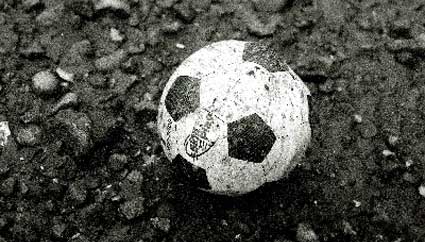
South African police, called in to advise Scotland Yard, recommended searching the river bank for candles and a sheet amongst other things that would be necessary for the ceremony to be complete.
The British police duly searched the river bank and found several sites where candles had been ceremoniously lit but none of these could be tied to the Tower Bridge case.
Three months after Adam was pulled from the water, police discovered candles and a sheet miles upstream from Tower Bridge. A name had been written three times on the sheet in blue ink and inscribed on the candles.
The man whose name was on the sheet was found in the US and said friends in the UK had held a prayer service seeking to protect him. The only logical conclusion that can be drawn from this is that the river Thames is host to many such ceremonies (if not as grotesque as Adam's) every year.

These offerings are keeping up a tradition that is at least 3,000 years old and very possibly older.
In 1998 the Thames Archaeological survey found the remains of a huge oak bridge built 3500 years ago not far from the present Vauxhall Bridge. The confluence of three rivers, where the Tyburn enters the Thames from the north and the Effra from the south, and the tidal turning point would have made this a sacred site for Bronze Age tribes.
Around the bridge were votive offerings of valuable goods to appease the spirits of the river. The Celts regarded rivers as bestowers of life, health, and plenty, and offered them rich gifts and sacrifices often at the same spots used by pre-Celtic British tribes.
At one time rivers were thought of as deities with powers to cure all kinds of ailments with south-running rivers possessing a special potency. Ways of appeasing water courses were devised in an attempt to stop them from claiming lives.
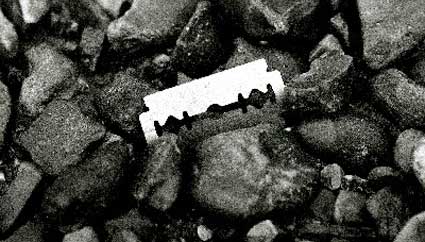
The River Tweed was known as a particularly bloodthirsty one, so salt was thrown into it and onto nets before they were cast in.
The Ribble, on the other hand, was less demanding: the spirit of the waterway, Peg O'Nell, only took one life in seven years, and could be placated with a sacrificial animal instead.
Sometimes the river itself hid or became an animal, the Scottish Each Uisge, or 'Water-horse', had staring eyes, webbed feet, and a slimy coat. It assumed different forms and lured the unwary to destruction, or he made love in human shape to women.

Tales of sacrifices of virgins to water serpents who threaten devastation if not placated can easily be seen as an oblation to the spirits of the river, or stream itself, and permeate mythology from across the world. Sirens and nymphs lived in the water in Greek mythology and the Rhine had the terrible Lorelie.
Offerings to rivers, wells and lakes still survive in today with the concept of the wishing well. Less well known is its equivalent, the cursing well, which received pins with which the spirit of the waters could harm the hexed person, as in 1815 when such a ceremony took place at Fynnon Elian in Denbigh.
Other examples show the sacrificial nature of the pin or other trifle might be symbolic or a survival of a more costly offering.
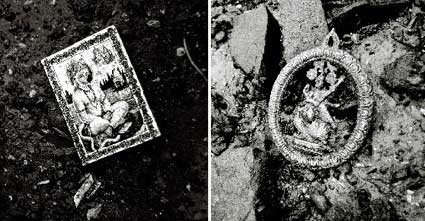
Pieces from Hindu shrine under Chelsea Bridge Autumn 2004.
River worship is a part of all the major world religions. Scattering the ashes on the waters of a sacred river after one's cremation is a Hindu rite.
A sect of Tibetan Buddhism holds Mani celebrations by the Tongtian River. Muslim clerics perform ritual cleansing in rivers such as the Wazzani, and Christianity has the tradition of baptism in water following the Biblical example of Christ in the Jordan.
Hindus and Sikhs living in Britain are campaigning for permission to be able to scatter the ashes of their dead relatives on the Thames as an alternative to the Ganges.

In Corinth at the Asklepian Temple to the Greek pantheon, offerings in the shape of a supplicant's limb that needs healing were made, and similar sympathetic magic was practised in London at the Roman Bridge built in 120 AD.
When the stone London Bridge was removed in 1832 a horde of coins, statues and images of pagan gods, some mutilated, were found at what would have been the centre of the older Roman crossing.
At one time it was thought that the disfigured pagan images might have been the result of destructive Christian religious zeal.
However their positioning in the centre of the river suggests that, as in Corinth, the damage was done to an afflicted part of the body that the supplicant wished to heal.
Oddly not all the offerings were found at the bridge site as recycling of bridge and dredged up material on the footpaths and Thames embankments meant that sacrifices originally made at London Bridge were still being discovered as far away as Putney in 1846.
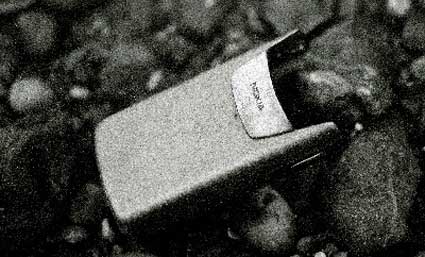
These should not be confused with events at other Thames sites such as the ford at Battersea which was used for votive offerings in pre-Christian times and also contained Roman remains.
When the Thames was dredged there in 1857 it turned up the ceremonial Battersea shield dating from 300 BC and in the 1860s an Iron Age helmet was found at Waterloo Bridge.
It is the only such helmet to have ever been found in southern England, and it is the only one with horns ever to have been found in Europe.
Two Bronze Age spearheads were found alongside the remains of the wooden structure leading out into the Thames at Vauxhall. The way they had been driven deep into the foreshore suggested they had been placed there deliberately as a ritual offering, rather than simply lost or abandoned in battle.

The river Thames has its own folk god, Old Father Thames, who is frequently portrayed as a bearded man, echoing the features of the traditional guardians of the City itself, Gog and Magog. His name is in recognition that the river is father to the settlements on its banks.
As the Romans prayed to Father Tiber, so Britons prayed to the Thames and fittingly there is a representation of Old Father Thames just upriver of Vauxhall Bridge on the southern shore.
The poet John Burns said the Thames is full of liquid history with shrines and sacred sites lining its banks devoted to many religions. Dorchester was the site of the baptism of King Cynegils in the river in 635 by St Birinus, and Christian baptisms still occasionally take place along the river in the 21st century.
A blend of pagan and Christian rite can be seen in the activities of bridge-building guilds. Bridge construction was considered holy work by the Catholic Church and London’s citizens were encouraged to make offerings of land and money 'to God and the Bridge'.

In 1176, during the reign of Henry II, it was Peter De Colechurch, a priest and head of the Fraternity of the Brethren of London Bridge, who began building the first stone bridge across the Thames.
In Italy a branch of the white friars, Freres Pontifis or brothers of the bridges, had a monopoly on bridge building for centuries.
The Pope's title of ‘sovereign pontiff’ derives from the chief priest of pagan Rome, the Pontifex Maximus or great bridge builder, himself a link between the divine and the mundane.
In other religions bridges have to be crossed to reach paradise after death and the unworthy are turned back or made to wait endlessly on the bridge.
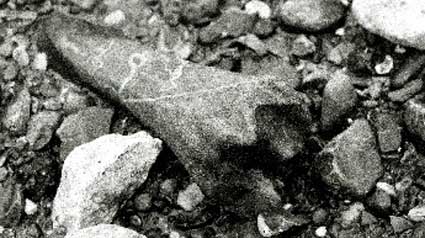
Even after the church came along to extol the Christian virtues of land and money, human sacrifice to the deities of a bridge or river took place across Europe.
The preferred offering involved children, their blood or, if possible, the sealing in of a child with a candle and hunk of bread at the foot of the bridge.
When the old bridge at Bremen was demolished in the 19th century the skeleton of a child was found in the foundations. In Romania it was believed that the sacrifice of a person’s shadow to a building or bridge would do the trick. People would be enticed to stand over the foundation and have their shadow measured.
This written measurement was then buried with the foundation stone. Sadly, it was also believed that the person whose shadow was buried in such a fashion would die within 40 days of the building’s completion.
So-called ‘shadow traders’ still existed in Eastern Europe until the 19th century and people would shout out warnings to those passing freshly-erected buildings to be beware in case someone stole their shadow.

Less disturbing offerings were made when the Thames bridges were constructed. At Blackfriars in 1760 an elaborate ceremony took place involving the burying of money and a plate under the central pile.
To mark the start of work on Hammersmith Bridge in May 1825 there was a Masonic ceremony with the Duke of Sussex, Augustus Frederick doing the honours.
In front of the Grand Lodge and a large crowd he performed a ritual that involved the fixing of a brass plate (praising the builders and designer) over one of the coffer dams into which had been placed gold coins and a silver trowel. As this was put in place the Duke poured corn over it saying:
'I have poured the corn, the oil and the wine, emblems of wealth, plenty and comfort, so may the bridge tend to communicate prosperity and wealth.'
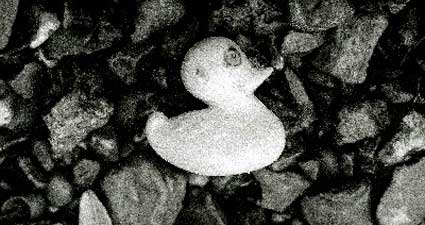
When work started on Waterloo Bridge in 1939 coins, postage stamps and all the daily newspapers were placed within a copper cylinder in the cavity under the official foundation stone, cut out of a stone from the old bridge.
This time capsule is obviously a less sinister offering to the river than Adam, and not all of today's ceremonial sites have menacing overtones. In 2004 a Hindu shrine was found near Chelsea Bridge consisting of candles, brass symbols, pictures of deities and photographs.
So trips to the foreshore can reveal traces of voodoo, Christianity and Hinduism alongside the detritus of the gods of consumer culture: mobile phones, credit cards, toys and in one recent instance, again at Chelsea Bridge, a vibrator.
It is probably stretching a point though to suggest that the person who mislaid it was continuing the Celtic tradition of offerings to rivers to honour their sexual power and potency.

CREDITS AND INFO
All photographs of Thames detritus by Paul Wright
WALKING CENTRAL LONDON'S BRIDGES
 Vauxhall to Waterloo route map and notes Vauxhall to Waterloo route map and notes
 Blackfriars to Tower route map and notes Blackfriars to Tower route map and notes
 Cross River Traffic Project and more on London's Bridges . Cross River Traffic Project and more on London's Bridges .
|

